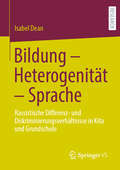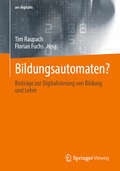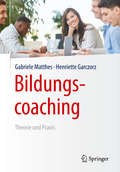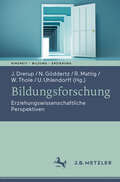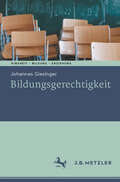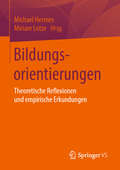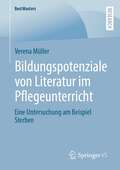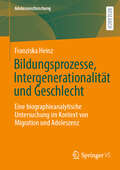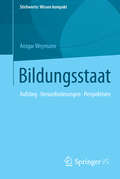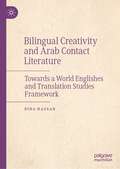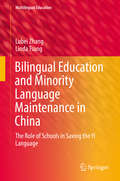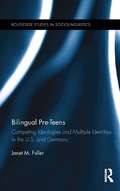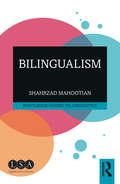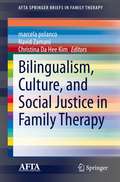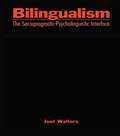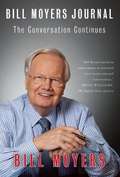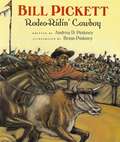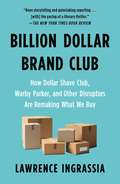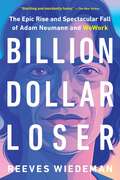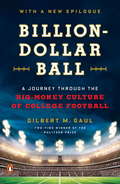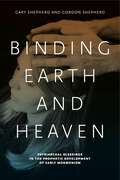- Table View
- List View
Bildung – Heterogenität – Sprache: Rassistische Differenz- und Diskriminierungsverhältnisse in Kita und Grundschule
by Isabel DeanIm Unterschied zum Sekundarschulbereich gelten Kita und Grundschule zumeist als Bildungsabschnitte, in denen alle Kinder gemeinsam, also unabhängig von Herkunft und diverser sozialer und natio-ethno-kulturell codierter Hintergründe zusammen lernen. Jedoch ereignen sich auch im Übergang von der Kita zur Grundschule diverse rassistische und mehrfachdiskriminierende Dynamiken. Die vorliegende Studie zeichnet verschiedene dieser potenziell diskriminierenden und segregierenden „neuralgischen Punkte“ nach, die sich auf der Ebene verschiedener Akteur*innengruppen, Diskurse, Konfliktlinien und Praktiken vollziehen.
Bildungsaufstieg, Biografie und familiale Figuration: Eine intergenerationale Studie (Rekonstruktive Bildungsforschung #37)
by Tina MaschmannWelche Wechselwirkungen bestehen zwischen sozialer Herkunft und dem Phänomen Bildungsaufstieg? Welche tradierten Wissensbestände und familialen Beziehungsdynamiken wirken sich begünstigend oder hinderlich auf den Prozess der Bildungsmobilität aus? Und welche Bewältigungsstrategien werden von Bildungsaufsteiger*innen und ihren Eltern im Hinblick auf die Veränderungen und Herausforderungen entwickelt, die durch intergenerationale soziale Mobilität entstehen? Diese Fragen beantwortet die Autorin mit einer biografietheoretischen Mehrgenerationenstudie. Sie rekonstruiert das komplexe Zusammenspiel von gesellschaftlichen Gelingensbedingungen, herkunftsbedingten Orientierungsstrukturen und familialen Beziehungsdynamiken in Familien, in denen die Kinder das Phänomen der sogenannten ‚Bildungsvererbung‘ überwinden. Es zeigt sich, dass sich ein Bildungsaufstieg immer im Spannungsfeld zwischen Loslösung von der Familie und Bindung an das Herkunftsmilieu bewegt und einen Sozialisationsprozess in alternativen sozialen Wirklichkeiten bedeutet.. In dieser Studie werden familiale Figurationen herausgearbeitet, die vor diesem Hintergrund Bildungsressourcen begründen oder auch Umstände, die im Prozess des Bildungsaufstiegs der biografischen oder familialen Bearbeitung bedürfen.
Bildungsautomaten?: Beiträge zur Digitalisierung von Bildung und Lehre (ars digitalis)
by Florian Fuchs Tim RaupachDer vorliegende Band versteht sich als interdisziplinäre Intervention in die aktuellen Debatten um die “Kultur der Digitalität” (Stalder) bzw. den Digitalisierungsprozess in Lehre und Unterricht. Die mit der Corona-Pandemie forcierte Digitalisierung von universitärer Lehre und Schulunterricht wird auf die ihr zugrundeliegende positivistisch-behavioristische Machbarkeitsideologie untersucht und somit als Teil eines neuen Herrschaftstypus sichtbar gemacht.
Bildungscoaching: Theorie und Praxis
by Gabriele Matthes Henriette GarczorzMit Bildungscoaching tritt seit einigen Jahren ein neues Coachingformat auf. Der Nutzen wird von Bildungsorganisationen und Teilnehmern an Bildungsprozessen zunehmend wahrgenommen. Die Vielfalt der Angebote wächst beständig. Es gibt verschiedene Ansätze zur Professionalisierung, indes keine verbindlichen Standards oder Evaluationsinstrumente. Anhand von wissenschaftlichen Hintergrundrecherchen, Fallbeispielen und Konzepten aus der Praxis sowie einer Befragung von Bildungscoaches bietet das Buch interessierten Lesern einen Überblick und eine Orientierungshilfe über die weite Landschaft des Bildungscoachings.
Bildungsforschung: Erziehungswissenschaftliche Perspektiven (Kindheit – Bildung – Erziehung. Philosophische Perspektiven)
by Johannes Drerup Werner Thole Nina Göddertz Ruprecht Mattig Uwe UhlendorffDer Begriff ‚Bildungsforschung‘ erweist sich als nicht minder umstritten als der Begriff der Bildung selbst. Bildungsforschung fungiert in der Diskussion häufig als eine Art Regenschirmbegriff, mit dem ein Forschungsprofil markiert wird, das es ermöglichen soll, schulische, insbesondere unterrichtsbezogene Bildungsprozesse empirisch zu erfassen und von Schüler*innen zu erwerbende Kompetenzen festzulegen und mit Hilfe quantitativer Verfahren zu evaluieren. Im Rahmen von anderen Forschungstraditionen geht man auf kritische Distanz zu diesem inhaltlich und methodisch allzu sehr eingeschränkten Verständnis von Bildungsforschung. Im Zentrum des Bandes stehen erziehungswissenschaftliche Zugänge und Beiträge zur Bildungsforschung und damit verbundene disziplinäre Perspektiven und forschungsmethodologische Fragestellungen.
Bildungsgerechtigkeit (Kindheit – Bildung – Erziehung. Philosophische Perspektiven)
by Johannes GiesingerIn unseren Bildungssystemen bestehen erhebliche soziale Ungleichheiten: Kinder aus sozial benachteiligten Familien sind schulisch weniger erfolgreich als Kinder wohlhabender und gebildeter Eltern, viele von ihnen erreichen minimale Kompetenzziele nicht. Ist das ungerecht? Dieses Buch nimmt eine normative Perspektive auf Ungleichheiten im Bildungsbereich ein. Es wird diskutiert, inwiefern es Sinn ergibt, Gleichheit (oder Chancengleichheit) anzustreben. Als Alternative wird eine Konzeption angemessener Bildung formuliert, nach der alle eine bestimme Schwelle in der Entwicklung relevanter Fähigkeiten entwickeln sollen. Die Tatsache, dass viele Heranwachsende heute diese Schwelle nicht erreichen, wird als die zentrale Bildungsungerechtigkeit dargestellt. Vor diesem Hintergrund wird das Problem der Begabtenförderung ebenso diskutiert wird die die Rolle von Privatschulen. Es geht um die Rechte der Eltern und das Wohl der Kinder, um die Digitalisierung der Schule und die Bedeutung von Bildungsgerechtigkeit für die Demokratie.
Bildungskontexte: Strukturelle Voraussetzungen und Ursachen ungleicher Bildungschancen
by Rolf Becker Alexander SchulzeGemäß dem meritokratischen Prinzip sollte alleine die Leistung eines Schülers, gemessen u. a. durch Schulnoten, dessen Bildungschancen bestimmen. Jedoch weist die umfangreiche empirische Bildungsforschung darauf hin, dass das deutsche Bildungssystem diesem Anspruch bei weitem und bis heute nicht gerecht wird. So belegen zahlreiche Studien ausgeprägte Ungleichheiten der Bildungschancenzwischen verschiedenen Sozialschichten und im Hinblick auf die ethnische Herkunft sowie das Geschlecht. Dabei gehen die angesprochenen empirischen Analysen (und die jeweils zugrunde liegenden theoretischen Konzepte) jedoch implizit häufig davon aus, dass alleine individuelle Determinanten für die festgestellten Bildungsungleichheiten ursächlich sind und es somit für die Bildungschancen vernachlässigbar ist, in welchem Klassen- und Schulkontext bzw. regionalem Umfeld oder sozialem Netzwerk sich eine Schülerin bzw. ein Schüler befindet. Neuere Untersuchungen auf Basis von Mehrebenenanalysen zeigen allerdings, dass auch die Bedingungen in den Klassen, Schulen und Regionen sowie die Lehrkräfte und die Zusammensetzung des Freundeskreises der Schüler einen erheblichen Einfluss auf den individuellen Bildungserfolg haben.
Bildungsorientierungen: Theoretische Reflexionen und empirische Erkundungen
by Michael Hermes Miriam LotzeAus der Perspektive qualitativ rekonstruktiver Forschung versammelt das Herausgeberwerk Beiträge zur Verortung von Bildungsorientierungen in Theorie und Empirie. Es entfalten sich unterschiedliche Facetten von Bildungsorientierungen. Schwerpunktsetzungen der Beiträge erfolgen u. a. mit Blick auf Bildungsinstitutionen und Familien sowie der Übergangs- und Ungleichheitsforschung. In der Gesamtschau der Beiträge wird die Heterogenität von Bildungsorientierungen auch in ihrer Relevanz für eine erziehungswissenschaftliche Forschung herausgearbeitet, die Bildungsprozesse – verortet in Lebensverläufen – zwischen Lebenswelt(en) und Institution(en) ergründet.
Bildungspotenziale von Literatur im Pflegeunterricht: Eine Untersuchung am Beispiel Sterben (BestMasters)
by Verena MüllerVerena Müller unternimmt den Versuch, eine Schnittstelle zwischen fiktionaler Literatur und der Pflegeausbildung herzustellen. Hierfür untersucht sie mit Blick in verschiedene Bezugswissenschaften, ob und wie der Einsatz von literarischen Texten den Weg zu einem ästhetischen Lernen im Pflegeunterricht bereitet. Dabei fokussiert sie exemplarisch den pflegerisch relevanten Zusammenhang von Tod und Sterben, um die Ausführungen zu rahmen. Dazu führt sie Erkenntnisse der Literaturdidaktik, der allgemeinen Erziehungswissenschaften und der Medical Humanities hinsichtlich des Einsatzes von literarischen Texten zusammen, setzt diese in Bezug zu den Zielen der Pflegedidaktik und leitet relevante Aspekte ab. Anknüpfend an die Ergebnisse zeigt sie in einer pflegedidaktischen Analyse zweier literarischer Texte beispielhaft pflegedidaktische Gewinne auf.
Bildungsprozesse, Intergenerationalität und Geschlecht: Eine biographieanalytische Untersuchung im Kontext von Migration und Adoleszenz (Adoleszenzforschung #15)
by Franziska HeinzFranziska Heinz widmet sich intergenerationalen Dynamiken in den Bildungsprozessen junger Frauen mit türkisch-deutscher Migrationsgeschichte. Ihre qualitativ-empirische Studie basiert auf narrativ-biographischen Interviews in zwei Generationen und fokussiert Zusammenhänge zwischen den biographischen Erfahrungen von Müttern und Vätern und deren Töchtern aus einer geschlechterkritischen Perspektive. Auf Basis der intergenerationalen Fallrekonstruktionen lassen sich verschiedene Bezugnahmen zwischen den adoleszenten Transformationsprozessen und Bildungsprozessen junger Frauen und den biographischen Erfahrungen, Bildungsaspirationen und generativen Haltungen ihrer Eltern im migrationsgesellschaftlichen Kontext beschreiben. Dabei werden sowohl biographische Herausforderungen als auch Ressourcen und Transformationspotentiale deutlich sowie deren gesellschaftliche Bedingungen.
Bildungsstaat: Aufstieg • Herausforderungen • Perspektiven (Stichworte: Wissen kompakt #0)
by Ansgar WeymannDersouveräne Bildungsstaat garantiert Bildung als Bürgerrecht und als attraktivepersönliche Lebenschance. Er nutzt Bildung zur Förderung vonWirtschaftswachstum und Wohlstand in einer Welt mit internationalem Wettbewerbauf immer mehr Gebieten und als Mittel sozialer und kultureller Integration derBevölkerung. Der Bildungsstaatwurde zum Stolz der Nationen und zum beliebten Instrument des Wohlfahrtsstaatesmit ausgreifenden sozialpolitischenInanspruchnahmen, eine moderneZivilreligion mit scheinbar unerschöpflichen Heilsversprechen. Doch die Grenzendes Wachstums sind sichtbar: Bildungserträge stagnieren, soziale Ungleichheitbleibt dauerhaft, das internationale Medieninteresse an Bildung schrumpft. Hatder Bildungsstaat seinen Gipfel erreicht? Oder durchläuft er einenInnovationszyklus im Zuge nichtwestlicher Globalisierung?
Bilingual Creativity and Arab Contact Literature: Towards a World Englishes and Translation Studies Framework
by Dina HassanThis book adopts an integrated approach to the study of contact literature through collaboration between theories of World Englishes and translation studies. The author proposes an interactive framework that integrates linguistic and cultural perspectives, through the analysis of selected Anglo-Arab and Arab-American contact literary texts: Samia Serageldine’s The Cairo House (2000), Leila Ahmed’s A Border Passage (1999), Leila Aboulela’s The Translator (1999), Ahdaf Soueif’s The Map of Love (2000), and Abdelkebir Khatibi’s Love in Two Languages (1990). The author then discusses the pedagogical implications of bilingual creativity via a language in literature approach. This book will be of interest to students and scholars of translation studies, literature and cultural studies.
Bilingual Education and Minority Language Maintenance in China: The Role of Schools in Saving the Yi Language (Multilingual Education #31)
by Linda Tsung Lubei ZhangThis book looks closely at Yi bilingual education practice in the southwest of China from an educationalist’s perspective and, in doing so, provides an insight toward our understanding of minority language maintenance and bilingual education implementation in China. The book provides an overview on the Yi people since 1949, their history, society, culture, customs and languages. Adopting the theory of language ecology, data was collected among different Yi groups and case studies were focused on Yi bilingual schools. By looking into the application of the Chinese government’s multilingual language and education policy over the last 30 years with its underlying language ideology and practices the book reveals the de facto language policy by analyzing the language management at school level, the linguistic landscape around the Yi community, as well as the language attitude and cultural identities held by present Yi students, teachers and parents. The book is relevant for anyone looking to more deeply understand bilingual education and language maintenance in today’s global context.
Bilingual Pre-Teens: Competing Ideologies and Multiple Identities in the U.S. and Germany (Routledge Studies in Sociolinguistics #6)
by Janet M. FullerThis volume examines the connection between socio-economic class and bilingual practices, a previously under-researched area, through looking at differences in bilingual settings that are classified as "immigrant" or "elite" and are thus linked to socio-economic class categories. Fuller chooses for this examination bilingual pre-teen children in Germany and the U.S. in order to demonstrate how local identities are embedded in a wider social world and how ideologies and identities both produce and reproduce each other. In so doing, she argues that while pre-teen children are clearly influenced by macro-level ideologies, they also have agency in how they choose to construct their identities with relation to hegemonic societal discourses, and have many other motivations and identities aside from social class membership which shape their linguistic practices.
Bilingualism (Routledge Guides to Linguistics)
by Shahrzad MahootianBilingualism provides a concise and lively introduction to bilingualism as a social and linguistic phenomenon and explains its impact on individuals and on society. Addressing questions such as what it means to be bilingual, how one becomes bilingual, and how exposure to more than one language can hinder or enhance a child’s cognitive development, this book features: an introduction to the linguistic, sociolinguistic, and cognitive outcomes of bilingualism, including bilingual language acquisition, the grammar of language-mixing, the link between language choice and identity, and the value of maintaining and promoting bilingualism; up-to-date overviews of the prominent concerns and facts about bilingualism; activities and discussion questions which invite readers to consider their own perspectives on bilingualism and how it manifests in their own lives and communities; links to relevant videos and suggested further reading, including topical novels, short stories, and essays. Aimed at students with no background in linguistics, this book is essential reading for anyone studying bilingualism for the first time.
Bilingualism, Culture, and Social Justice in Family Therapy (AFTA SpringerBriefs in Family Therapy)
by Marcela Polanco Navid Zamani Christina Da Hee KimThis volume advocates for justice in language rights through its explorations of bilingualism in family therapy, from the perspectives of eighteen languages identified by the authors: Black Talk/Ebonics/Slang, Farsi, Fenglish, Arabic, Italian, Cantonese Chinese, South Korean, Mandarin Chinese, Vietnamese, Spanish, Chilean Spanish, Mexican Spanish, Colombian Spanglish, Madrileño Spanish, Spanglish, Pocho Spanish, Colloquial Spanish, and English. It identifies standard English as the current language most often used across family therapy programs and services in the United States. The book discusses efforts to respond to the rapidly changing linguistic landscape and the increasingly high demand for appropriate therapy services that respond effectively to diverse families in America. It discusses recruitment and training of linguistically diverse family therapists and strategies to promote linguistic equality to support the rights of family therapists, their practices, and the communities they serve. Chapters explore ways to integrate languages in professional and personal lives, including the improvisational, self-taught translanguaging skills and practices that go beyond the lexical and grammatical rules of a language. The book describes the creative use of native or heritage languages to ensure that the juxtaposition of English therapeutic and daily-life landscapes is integrated into family therapy settings. It discusses contextual, relational, therapeutic, and training potential offered by bilingualism as well as the necessary transmutations in theory and practice. This volume is an essential resource for clinicians, therapists, and practitioners as well as researchers, professors, and graduate students in family studies, clinical psychology, and public health as well as all interrelated disciplines.
Bilingualism: The Sociopragmatic-Psycholinguistic Interface
by Joel WaltersIn the past 30 years, the study of bilingualism processing has been conducted independently by two fields, psycholinguistics and sociolinguistics. This volume merges these two fields, addressing one of the tough problems dividing researchers in bilingualism, conceptually as well as methodologically. Joel Walters proposes a new approach to bilingualism processing--the Sociopragmatic-Psycholinguistic (SPPL) Model--which presents language as a social phenomenon. The author accomplishes this by identifying and organizing evidence from a wide range of linguistic disciplines, merging sociopragmatics, discourse analysis, and ethnography with social cognition, psycholinguistics, and neuroscience. By extension, the author offers convincing explanations of how related fields can profit from a comprehensive bilingual processing model. As a result, Joel Walters delivers a well-organized, comprehensive model that is thought through at every level. This book appeals to graduate students, scholars in the fields of linguistics, bilingualism, second language acquisition, psycholinguistics, and sociolinguistics. It is useful to researchers for its comprehensiveness and methodological acumen and may be appropriate as a supplementary textbook for graduate-level courses in bilingualism or for seminars on similar topics.
Bill Moyers Journal: The Conversation Continues
by Bill MoyersOne of the most highly rated public affairs programmes on American television, Bill Moyers' Journal drew up to two million weekly viewers from 2007 to 2010. With incisive, morally engaging text, this stunning companion brings Moyers' groundbreaking work to the page. Featuring extensive new commentary from Bill Moyers, it is an unparalleled guide to the debates, the cultural currents and above all the fascinating people that have so powerfully shaped today's world.
Bill Pickett: Rodeo-ridin' Cowboy
by Andrea Davis Pinkney Brian PinkneyThe true sweat-and-dirt tale of the feisty cowboy-child who became the most famous black rodeo performer who ever lived. Includes a note about the history of the black West and a bibliography.
Billion Dollar Brand Club: How Dollar Shave Club, Warby Parker, and Other Disruptors Are Remaking What We Buy
by Lawrence IngrassiaA leading business journalist takes us inside a business revolution: the upstart brands taking on the empires that long dominated the trillion-dollar consumer economy.Dollar Shave Club and its hilarious marketing. Casper mattresses popping out of a box. Third Love’s lingerie designed specifically for each woman’s body. Warby Parker mailing you five pairs of glasses to choose from. You’ve seen their ads. You (or someone you know) use their products. Each may appear, in isolation, as a rare David with the bravado to confront a Goliath, but taken together they represent a seismic shift in a business model that has lasted more than a century.As Lawrence Ingrassia--former business and economics editor and deputy managing editor at the New York Times--shows in this timely and eye-opening book, a growing number of digital entrepreneurs have found new and creative ways to crack the code on the bonanza of physical goods that move through our lives every day. They have discovered that manufacturing, marketing, logistics, and customer service have all been flattened—where there were once walls that protected big brands like Gillette, Sealy, Victoria’s Secret, or Lenscrafters, savvy and hungry innovators now can compete on price, value, quality, speed, convenience, and service. Billion Dollar Brand Club reveals the world of the entrepreneurs, venture capitalists, and corporate behemoths battling over this terrain. And what fun it is. It’s a massive, high-stakes business saga animated by the personalities, flashes of insight, and stories behind the stuff we use every day.
Billion Dollar Loser: The Epic Rise and Spectacular Fall of Adam Neumann and WeWork
by Reeves Wiedeman&“Vivid, carefully reported drama that readers will gulp down as if it were a fast-paced novel&” (Ken Auletta) ꟷ the inside story of WeWork and its CEO, Adam Neumann, which tells the remarkable saga of one of the most audacious, and improbable, rises and falls in American business history In its earliest days, WeWork promised the impossible: to make the American work place cool. Adam Neumann, an immigrant determined to make his fortune in the United States, landed on the idea of repurposing surplus New York office space for the burgeoning freelance class. Over the course of ten years, WeWork attracted billions of dollars from some of the most sought-after investors in the world, while spending it to build a global real estate empire that he insisted was much more than that: an organization that aspired to nothing less than "elevating the world's consciousness." Moving between New York real estate, Silicon Valley venture capital, and the very specific force field of spirituality and ambition erected by Adam Neumann himself, Billion Dollar Loser lays bare the internal drama inside WeWork. Based on more than two hundred interviews, this book chronicles the breakneck speed at which WeWork&’s CEO built and grew his company along with Neumann&’s relationship to a world of investors, including Masayoshi Son of Softbank, who fueled its chaotic expansion into everything from apartment buildings to elementary schools. Culminating in a day-by-day account of the five weeks leading up to WeWork&’s botched IPO and Neumann&’s dramatic ouster, Wiedeman exposes the story of the company&’s desperate attempt to secure the funding it needed in the final moments of a decade defined by excess. Billion Dollar Loser is the first book to indelibly capture the highly leveraged, all-blue-sky world of American business in President Trump&’s first term, and also offers a sober reckoning with its fallout as a new era begins.
Billion-Dollar Ball
by Gilbert M. Gaul"A penetrating examination of how the elite college football programs have become 'a giant entertainment businesses that happened to do a little education on the side.'"--Mark Kram, The New York TimesTwo-time Pulitzer-Prize-winning journalist Gilbert M. Gaul offers a riveting and sometimes shocking look inside the money culture of college football and how it has come to dominate a surprising number of colleges and universities. Over the past decade college football has not only doubled in size, but its elite programs have become a $2.5-billion-a-year entertainment business, with lavishly paid coaches, lucrative television deals, and corporate sponsors eager to slap their logos on everything from scoreboards to footballs and uniforms. Profit margins among the top football schools range from 60% to 75%--results that dwarf those of such high-profile companies as Apple, Facebook and Microsoft--yet thanks to the support of their football-mad representatives in Congress, teams aren't required to pay taxes. In most cases, those windfalls are not passed on to the universities themselves, but flow directly back into their athletic departments.College presidents have been unwilling or powerless to stop a system that has spawned a wildly profligate infrastructure of coaches, trainers, marketing gurus, and a growing cadre of bureaucrats whose sole purpose is to ensure that players remain academically eligible to play. From the University of Oregon's lavish $42 million academic center for athletes to Alabama coach Nick Saban's $7 million paycheck--ten times what the school pays its president, and 70 times what a full-time professor there earns--Gaul examines in depth the extraordinary financial model that supports college football and the effect it has had not only on other athletic programs but on academic ones as well. What are the consequences when college football coaches are the highest paid public employees in over half the states in an economically troubled country, or when football players at some schools receive ten times the amount of scholarship awards that academically gifted students do? Billion-Dollar Ball considers these and many other issues in a compelling account of how an astonishingly wealthy sports franchise has begun to reframe campus values and distort the fundamental academic mission of our universities.From the Hardcover edition.
Billion-Dollar Ball: A Journey Through the Big-Money Culture of College Football
by Gilbert M. Gaul* A Boston Globe Best Book of 2015 * <P><P>"A penetrating examination of how the elite college football programs have become 'giant entertainment businesses that happened to do a little education on the side.'"--Mark Kram, The New York Times <P><P>Two-time Pulitzer-Prize-winning journalist Gilbert M. Gaul offers a riveting and sometimes shocking look inside the money culture of college football and how it has come to dominate a surprising number of colleges and universities. <P><P>Over the past decade college football has not only doubled in size, but its elite programs have become a $2.5-billion-a-year entertainment business, with lavishly paid coaches, lucrative television deals, and corporate sponsors eager to slap their logos on everything from scoreboards to footballs and uniforms. <P><P>Profit margins among the top football schools range from 60% to 75%--results that dwarf those of such high-profile companies as Apple, Facebook, and Microsoft--yet thanks to the support of their football-mad representatives in Congress, teams aren't required to pay taxes. <P><P>In most cases, those windfalls are not passed on to the universities themselves, but flow directly back into their athletic departments. <P><P>College presidents have been unwilling or powerless to stop a system that has spawned a wildly profligate infrastructure of coaches, trainers, marketing gurus, and a growing cadre of bureaucrats whose sole purpose is to ensure that players remain academically eligible to play. <P><P>From the University of Oregon's lavish $42 million academic center for athletes to Alabama coach Nick Saban's $7 million paycheck--ten times what the school pays its president, and 70 times what a full-time professor there earns--Gaul examines in depth the extraordinary financial model that supports college football and the effect it has had not only on other athletic programs but on academic ones as well. <P><P>What are the consequences when college football coaches are the highest paid public employees in over half the states in an economically troubled country, or when football players at some schools receive ten times the amount of scholarship awards that academically gifted students do? <P><P>Billion-Dollar Ball considers these and many other issues in a compelling account of how an astonishingly wealthy sports franchise has begun to reframe campus values and distort the fundamental academic mission of our universities.From the Hardcover edition.
Billionaire Wilderness: The Ultra-Wealthy and the Remaking of the American West (Princeton Studies in Cultural Sociology #83)
by Justin FarrellA revealing look at the intersection of wealth, philanthropy, and conservationBillionaire Wilderness takes you inside the exclusive world of the ultra-wealthy, showing how today's richest people are using the natural environment to solve the existential dilemmas they face. Justin Farrell spent five years in Teton County, Wyoming, the richest county in the United States, and a community where income inequality is the worst in the nation. He conducted hundreds of in-depth interviews, gaining unprecedented access to tech CEOs, Wall Street financiers, oil magnates, and other prominent figures in business and politics. He also talked with the rural poor who live among the ultra-wealthy and often work for them. The result is a penetrating account of the far-reaching consequences of the massive accrual of wealth, and an eye-opening and sometimes troubling portrait of a changing American West where romanticizing rural poverty and conserving nature can be lucrative—socially as well as financially.Weaving unforgettable storytelling with thought-provoking analysis, Billionaire Wilderness reveals how the ultra-wealthy are buying up the land and leveraging one of the most pristine ecosystems in the world to climb even higher on the socioeconomic ladder. The affluent of Teton County are people burdened by stigmas, guilt, and status anxiety—and they appropriate nature and rural people to create more virtuous and deserving versions of themselves. Incisive and compelling, Billionaire Wilderness reveals the hidden connections between wealth concentration and the environment, two of the most pressing and contentious issues of our time.
Binding Earth and Heaven: Patriarchal Blessings in the Prophetic Development of Early Mormonism
by Gary Shepherd Gordon ShepherdIn Binding Earth and Heaven, Gary Shepherd and Gordon Shepherd use early nineteenth-century Mormonism as a case study to examine questions about how new religious movements may, as rare exceptions, survive and even eventually become successful in spite of intense opposition. Initial scorn and contempt for Mormonism—the fledgling creation of the young Joseph Smith—quickly elevated to mob violence as both Smith’s innovative teachings and converted followers proliferated, resulting in the widely held perception that the Mormons constituted a social menace. This book examines how Mormonism attracted and maintained the loyalty of increasing numbers of people despite mounting hostilities and severe hardships. The book focuses on the unique Mormon ritual (and accompanying doctrinal underpinnings) of “patriarchal blessings.” Patriarchal blessings were an innovative adaptation of the Old Testament practice of fathers making quasi-legal pronouncements over the heads of their sons—a way of verbally conferring rights, promises, admonition, and guidance to heirs. Binding Earth and Heaven shows how the organizational complexities of this practice contributed to strengthening and sustaining member faith and fealty, thereby bolstering the continuity and development of Mormonism.
